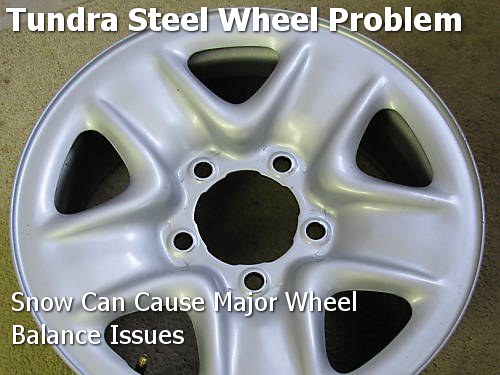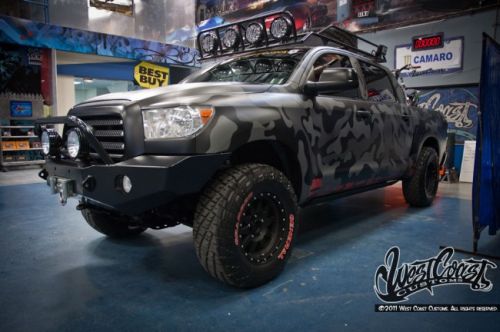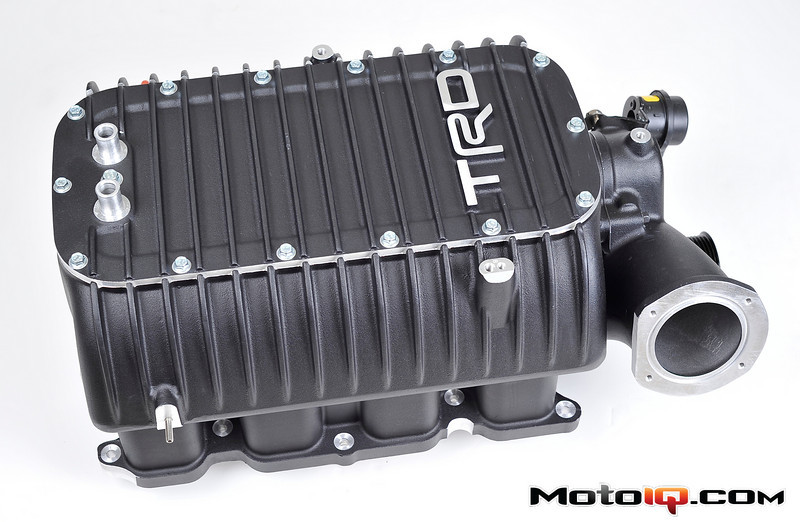
 Author Archive for Benjamin
Author Archive for Benjamin
Benjamin Hunting is a freelance automotive writer who has been involved in racing, restoring and writing about cars and trucks for more than a decade. In his spare time he enjoys keeping the shiny side up on track days. You can find out more about Benjamin’s writing at his website, http://www.benjaminhunting.com.
Tundra Steel Wheel Problem – Snow and Ice Can Cause Vibrations
Tire and wheel balance is an important aspect of ensuring that your driveline is free of any annoying vibrations or steering pulls while traveling at speed. Most of us have experienced a situation where a balancing weight has fallen off of one of our front rims and introduced an annoying shake that can be felt through the steering wheel. There may have been other times, however, where you have encountered unexplained wheel vibrations that seem to come and go while shrouded entirely in mystery.

Tundra steel wheels have a narrow lip that can collect ice and create wheel balance havoc
This is particularly true if you live in a northern climate where snow and ice are a regular feature of winter weather. If the stars align just right – and by stars, I mean weather conditions and driving habits – then you might fall victim to wheel unbalancing as a result of the elements.
Let me explain. The stock Toyota Tundra steel rims are designed with an interior lip that is almost invisible while the wheels are installed on the truck, but which can be seen after removing and reversing the units. This lip looks fairly harmless, and indeed it is, if the region you call home has mild winters. In colder areas, however, this lip has the unfortunate propensity to catch snow and ice and hold it there, where its weight unbalances the wheel and can in worst case scenarios make the truck completely undrivable at speeds of more than 45 miles per hour.
“Ox-Tundra” Becomes Memorial Tribute to Jeff “Ox” Kangola
No one ever sets out to build a project truck that ends up being a memorial to its owner. In the case of the West Coast Customs effort for Jeff “Ox” Kangola, however, it is hard to think of a more fitting tribute to one of the premier off-road riders of the past several years than the Toyota Tundra pickup that was put together for him by the talented craftsmen at the California garage.

The 2010 "Ox-Tundra" seen from the front.
Jeff Kangola passed away last month as the result of injuries sustained in a dirt bike accident. Prior to his passing, “Ox” Kangola’s motocross accomplishments included a silver at the 2005 Winter X Games for Best Trick, the 2004 WFA Big Air Points Championship and a number of impressive finishes in SCORE Baja competition.
Ryan Friedlinghaus and his crew of mechanics, designers, body and paint men debuted the 2010 Toyota Tundra that they build for Kangola in March on the Inside West Coast Customs program that airs on Discovery’s HD Theatre channel. Dubbed the “Ox-Tundra,” the goal was to build a pickup that could incorporate some of the elements needed to survive the grueling Baja race environment that Kangola regularly conquered on his bike. At the same time, Friedlinghaus challenged his team to also produce a truck that could match the “Metal Mulisha” team style worn by Kangola, which made use of a number of dark and sinister elements in its branding and colors.
Search terms people used to find this page:
- tundraheadquarters
MotoIQ Project Tundra Update – TRD Supercharger Time
When we last checked in on the MotoIQ Toyota Tundra Project just a few short months ago, the truck had been tastefully customized with a few practical accessories, seen its paint and windows protected by 3M film and had a TRD cold air intake, air filter and high performance brake pads installed. This gave it a nice mix of both “show” and “go.”

The advanced roots-style supercharger that comes with the TRD kit.
Well, the latest chapter in the MotoIQ Tundra Project sees the “go” aspect turned up to 11, thanks to the decision to boost engine output through the use of a TRD supercharger kit. The pickup’s 5.7 liter V8 will be treated to an Eaton TVS supercharger that includes an intercooler and which provides a very healthy 504 horsepower and 550 lb-ft of torque, with the latter starting a nice and low 4000 rpm.
Tundra Traction Control Comparison Videos – A Tale of Two Agendas
They say a picture is worth a thousand words, and in the world of viral video, a YouTube link can spew forth opinions at a rate many times that of a single photograph. There’s no denying the power of a well put together video, especially in the automotive world where many drivers adopt the attitude of “seeing is believing” when it comes to performance.
Unfortunately, just because a video has been produced in a professional and well-executed manner, there is no guarantee that the information presented is impartial. Promotional videos released via thinly-disguised publicity campaigns which adopt an air of third-party legitimacy are inherently deceptive. This is just as true in “political action committee” TV ads as it is in the hotly-contested full-size pickup truck market, where so much emphasis is put on comparing and contrasting the capabilities of the offerings from Ford, Chevrolet, Dodge and Toyota.
What you’re about to see is two different videos, each of which claims to do the exact same test…but with very different results. [Spoiler alert: GM lied about the way their trucks compare to the Tundra.]
Active Aerodynamics and Pickup Truck Fuel Economy
Aerodynamics plays more of a role in automobile fuel efficiency than many people realize. In fact, when looking at vehicles as large as trucks even small tweaks to a body shape’s aero profile can pay dividends in terms of reducing gas consumption at highway speeds.
What Is Active Aero?
In the pursuit of better fuel economy, many automakers are turning to the field of active aerodynamics. Performance enthusiasts are most likely familiar with active aero applications in the racing and high-end sports car world, where spoilers deploy at certain speeds to help achieve greater straight-line stability, or air brakes pop up in order to haul racers down from triple digit speeds as quickly as possible. When it comes to fuel economy, active aerodynamics plays a more subtle, but no less important role in changing the flow of air around an automobile in order to maximize its slipperiness and reduce the amount of energy needed to keep it moving forward at a specific speed.

